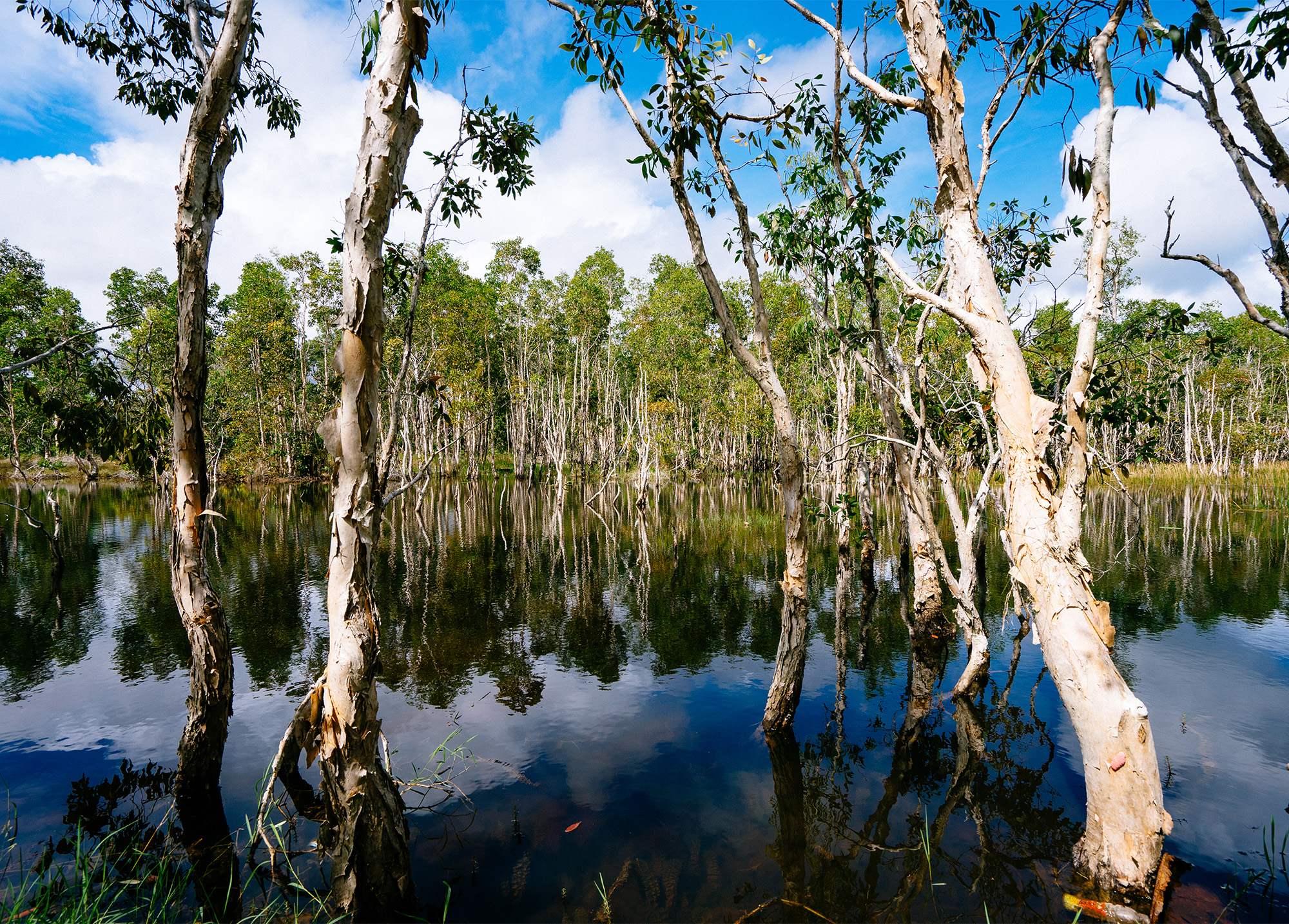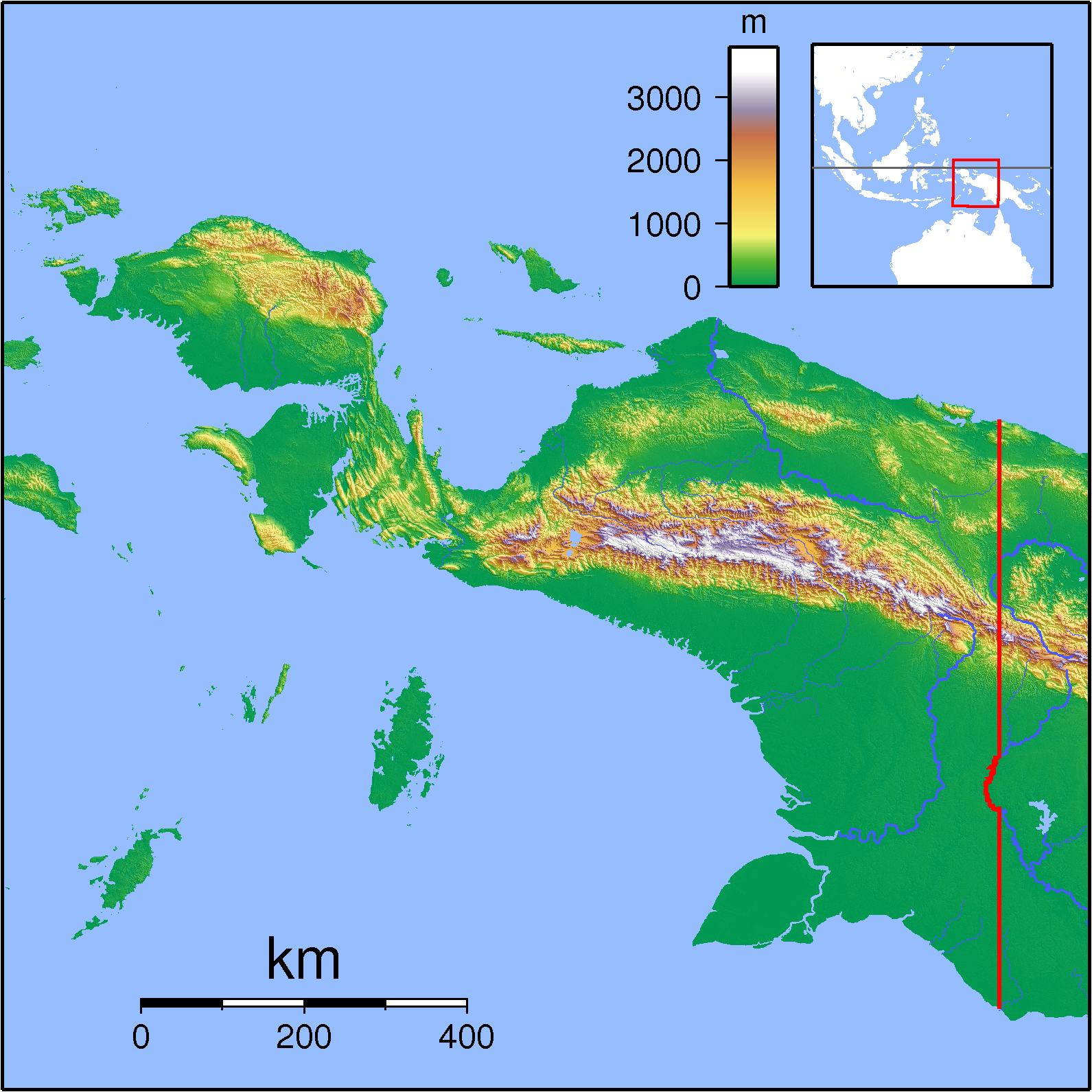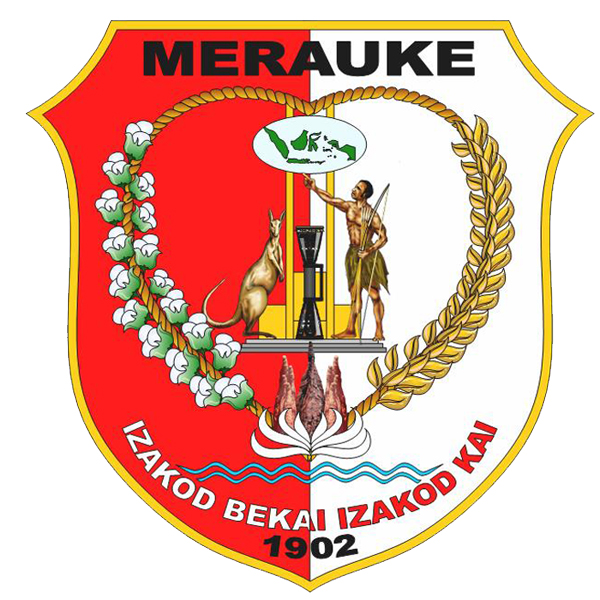|
Maro River
The Maro River also known as Sungai Merauke and Merauke-rivier, Merauki River flows in Merauke Regency, Papua, Indonesia. It is located just to the west of the Bensbach River of Western Province, Papua New Guinea. Hydrology The Maro flows from north-east to south-west, into the Arafura Sea. Its total length is 207 km and width around 48 - 900.1 m. The river is strongly tidal for most of its length and its lower reaches are affected by salt water. The main tributaries are Obat, also known as Oba. Associated with the river is a complex system of swamps and oxbow lakes which are of great importance for a large number of birds and reptiles. The Maro river borders the northern side of Wasur National Park. , retrieved 2009-10-30 |
Papua (province)
Papua is a province of Indonesia, comprising the northern coast of Western New Guinea together with island groups in Cenderawasih Bay to the west. It roughly follows the borders of Papuan customary region of Tabi Saireri. It is bordered by the sovereign state of Papua New Guinea to the east, the Pacific Ocean to the north, Cenderawasih Bay to the west, and the provinces of Central Papua and Highland Papua to the south. The province also shares maritime boundaries with Palau in the Pacific. Following the splitting off of twenty regencies to create the three new provinces of Central Papua, Highland Papua, and South Papua on 30 June 2022, the residual province is divided into eight regencies (''kabupaten'') and one city (''kota''), the latter being the provincial capital of Jayapura. The province has a large potential in natural resources, such as gold, nickel, petroleum, etc. Papua, along with four other Papuan provinces, has a higher degree of autonomy level compared to other ... [...More Info...] [...Related Items...] OR: [Wikipedia] [Google] [Baidu] |
Maoke Mountains
The Maoke Mountains is a mountain range in the province of Central Papua and Highland Papua. It extends over 692 km and is composed of the Sudirman and Jayawijaya ranges. It is part of the larger New Guinea Highlands or Central Cordillera. Although ''Maoke'' means 'snow' in the local language, the glacier on Puncak Trikora Puncak Trikora, until 1963 Wilhelmina Peak, is a 4,730 or mountain in the Highland Papua province of Indonesia on New Guinea. It lies in the eastern part of the Sudirman (Nassau) Range of the Maoke Mountains. Behind Puncak Jaya (Carstensz Pyr ... in the Maoke Mountains disappeared completely some time between 1939 and 1962. References External links UGSG Satellite Image Atlas of Glaciers of the World Mountain ranges of Western New Guinea Geography of New Guinea {{HPapua-geo-stub ... [...More Info...] [...Related Items...] OR: [Wikipedia] [Google] [Baidu] |
Arafura Sea
The Arafura Sea (or Arafuru Sea) lies west of the Pacific Ocean, overlying the continental shelf between Australia and Western New Guinea (also called Papua), which is the Indonesian part of the Island of New Guinea. Geography The Arafura Sea is bordered by the Gulf of Carpentaria and the continent of Australia to the south, the Timor Sea to the west, the Banda and Seram seas to the northwest, and the Torres Strait to the east. (Just across the strait, farther to the east, lies the Coral Sea). The Arafura Sea is long and wide. The depth of the sea is in most places, with the depth increasing to the west. The sea lies over the Arafura Shelf, which is a section of the Sahul Shelf. When sea levels were low during the last glacial maximum, the Arafura Shelf, the Gulf of Carpentaria and the Torres Strait formed a large, flat, land bridge that connected Australia and New Guinea and eased the migration of humans from Asia into Australia. The combined landmass formed the continent of ... [...More Info...] [...Related Items...] OR: [Wikipedia] [Google] [Baidu] |
Papua New Guinea
Papua New Guinea (abbreviated PNG; , ; tpi, Papua Niugini; ho, Papua Niu Gini), officially the Independent State of Papua New Guinea ( tpi, Independen Stet bilong Papua Niugini; ho, Independen Stet bilong Papua Niu Gini), is a country in Oceania that comprises the eastern half of the island of New Guinea and its offshore islands in Melanesia (a region of the southwestern Pacific Ocean north of Australia). Its capital, located along its southeastern coast, is Port Moresby. The country is the world's third largest island country, with an area of . At the national level, after being ruled by three external powers since 1884, including nearly 60 years of Australian administration starting during World War I, Papua New Guinea established its sovereignty in 1975. It became an independent Commonwealth realm in 1975 with Elizabeth II as its queen. It also became a member of the Commonwealth of Nations in its own right. There are 839 known languages of Papua New Guinea, one of ... [...More Info...] [...Related Items...] OR: [Wikipedia] [Google] [Baidu] |
Indonesia
Indonesia, officially the Republic of Indonesia, is a country in Southeast Asia and Oceania between the Indian and Pacific oceans. It consists of over 17,000 islands, including Sumatra, Java, Sulawesi, and parts of Borneo and New Guinea. Indonesia is the world's largest archipelagic state and the 14th-largest country by area, at . With over 275 million people, Indonesia is the world's fourth-most populous country and the most populous Muslim-majority country. Java, the world's most populous island, is home to more than half of the country's population. Indonesia is a presidential republic with an elected legislature. It has 38 provinces, of which nine have special status. The country's capital, Jakarta, is the world's second-most populous urban area. Indonesia shares land borders with Papua New Guinea, East Timor, and the eastern part of Malaysia, as well as maritime borders with Singapore, Vietnam, Thailand, the Philippines, Australia, Palau, and India ... [...More Info...] [...Related Items...] OR: [Wikipedia] [Google] [Baidu] |
Western New Guinea
Western New Guinea, also known as Papua, Indonesian New Guinea, or Indonesian Papua, is the western half of the Melanesian island of New Guinea which is administered by Indonesia. Since the island is alternatively named as Papua, the region is also called West Papua ( id, Papua Barat). Lying to the west of Papua New Guinea and considered a part of the Australian continent, the territory is almost entirely in the Southern Hemisphere and includes the Schouten and Raja Ampat archipelagoes. The region is predominantly covered with ancient rainforest where numerous traditional tribes live such as the Dani of the Baliem Valley although a large proportion of the population live in or near coastal areas with the largest city being Jayapura. Within five years following its proclamation of independence in 1945, the Republic of Indonesia (for a time part of the United States of Indonesia) took over all the former territories of the Dutch East Indies except Western New Guinea, acco ... [...More Info...] [...Related Items...] OR: [Wikipedia] [Google] [Baidu] |
Merauke Regency
Merauke Regency is a regency in the far south of the Indonesian province of South Papua. It covers an area of 46,791.63 km2, and had a population of 195,716 at the 2010 Census and 230,932 at the 2020 Census; the official estimate as at mid 2021 was 231,696, comprising 121,078 males and 110,618 female inhabitants. The administrative centre is the town of Merauke; this was projected since 2013 to become an independent city (''kota'') separate from Merauke Regency, but the alteration has been deferred. It is also the provincial capital of South Papua since 2022. History The regency formerly covered a much wider area of southern Papua, but much of the area was split off on 12 November 2002 to form the new Regencies of Asmat, Mappi and Boven Digoel. These regencies have in 2022 been re-grouped to form the new South Papua Province. Administrative districts Merauke Regency comprises twenty districts (''distrik''), listed below with their areas and populations at the 2010 Census ... [...More Info...] [...Related Items...] OR: [Wikipedia] [Google] [Baidu] |
Bensbach River
The Bensbach River is a river in southwestern Papua New Guinea. It is located just to the east of the Maro River in Merauke Regency, Indonesia, and just to the west of the Morehead River in Papua New Guinea. The mouth of the river, Torasi Estuary, marks part of the extreme southern boundary between Papua New Guinea and Indonesia. The river is strongly meandering and rather narrow. From the rivermouth, it stretches in a roughly northeasterly direction, and so is entirely located in PNG territory. It flows through the Trans-Fly savanna and grasslands, including the Tonda Wildlife Management Area. Europeans first discovered the river on 27 February 1893, and it was named after Jacob Bensbach, Dutch Resident at Ternate, by Sir William MacGregor. The local people call it the Torassi (sometimes spelled Torasi). Tonda languages are spoken in the Bensbach River area. See also *List of rivers of Papua New Guinea *Western Province (Papua New Guinea) * Tonda Wildlife Management Area ... [...More Info...] [...Related Items...] OR: [Wikipedia] [Google] [Baidu] |
Western Province, Papua New Guinea
Western Province is a coastal province in southwestern Papua New Guinea, bordering the Indonesian province of Papua (Indonesian province), Papua. The provincial capital (political), capital is Daru. The largest town in the province is Tabubil, Papua New Guinea, Tabubil. Other major settlements are Kiunga, Papua New Guinea, Kiunga, Ningerum, Olsobip and Balimo. The provincial government has, as with the governments of Bougainville Province, North Solomons, Simbu Province, Chimbu and Oro Province, Northern provinces, sought to change the name of the province. The government uses the name Fly River Provincial Government; however, this remains unofficial as it has not been changed in the Constitution of Papua New Guinea. Geography and ecology Western Province covers 99,300 km² and is the largest province in Papua New Guinea by area. There are several large rivers that run through the province, including the Fly River and its tributary, tributaries the Strickland River, Strickla ... [...More Info...] [...Related Items...] OR: [Wikipedia] [Google] [Baidu] |
Swamps
A swamp is a forested wetland.Keddy, P.A. 2010. Wetland Ecology: Principles and Conservation (2nd edition). Cambridge University Press, Cambridge, UK. 497 p. Swamps are considered to be transition zones because both land and water play a role in creating this environment. Swamps vary in size and are located all around the world. The water of a swamp may be fresh water, brackish water, or seawater. Freshwater swamps form along large rivers or lakes where they are critically dependent upon rainwater and seasonal flooding to maintain natural water level fluctuations.Hughes, F.M.R. (ed.). 2003. The Flooded Forest: Guidance for policy makers and river managers in Europe on the restoration of floodplain forests. FLOBAR2, Department of Geography, University of Cambridge, Cambridge, UK. 96 p. Saltwater swamps are found along tropical and subtropical coastlines. Some swamps have hammock (ecology), hammocks, or dry-land protrusions, covered by aquatic vegetation, or vegetation that tolerates ... [...More Info...] [...Related Items...] OR: [Wikipedia] [Google] [Baidu] |
Oxbow Lake
An oxbow lake is a U-shaped lake or pool that forms when a wide meander of a river is cut off, creating a free-standing body of water. In South Texas, oxbows left by the Rio Grande are called '' resacas''. In Australia, oxbow lakes are called billabongs. The word "oxbow" can also refer to a U-shaped bend in a river or stream, whether or not it is cut off from the main stream. Geology An oxbow lake forms when a meandering river erodes through the neck of one of its meanders. This takes place because meanders tend to grow and become more curved over time. The river then follows a shorter course that bypasses the meander. The entrances to the abandoned meander eventually silt up, forming an oxbow lake. Because oxbow lakes are stillwater lakes, with no current flowing through them, the entire lake gradually silts up, becoming a bog or swamp and then evaporating completely. When a river reaches a low-lying plain, often in its final course to the sea or a lake, it meanders wi ... [...More Info...] [...Related Items...] OR: [Wikipedia] [Google] [Baidu] |
Wasur National Park
The Wasur National Park forms part of the largest wetland in Merauke Regency, South Papua, Indonesia and has been one of the least disturbed by human activity.Indonesian Ministry of Forestry retrieved 2009-10-30 The high value of its has led to the park being dubbed the "Serengeti of Papua". The vast open wetland, in particular Rawa Biru Lake, attracts a very rich fauna. Vegetation and fauna  About 70% of the total area of ...
About 70% of the total area of ...
[...More Info...] [...Related Items...] OR: [Wikipedia] [Google] [Baidu] |





